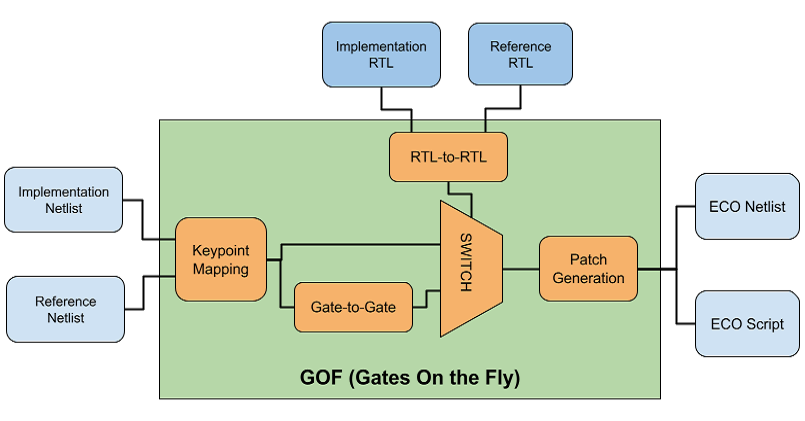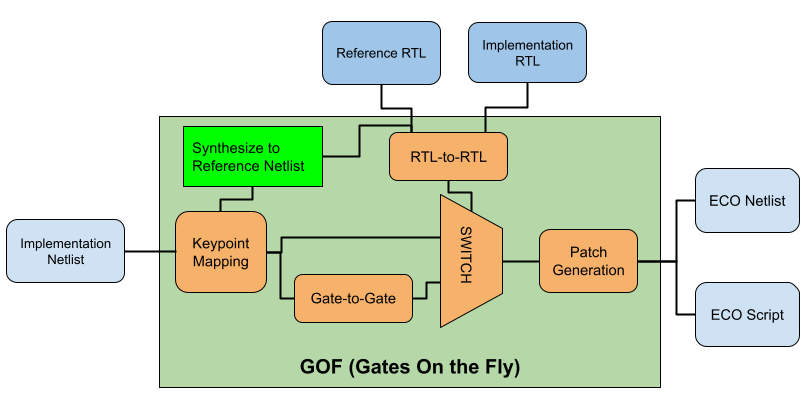RTL-guided ECO employs two approaches: utilizing the built-in RTL logic equivalence checking engine of GOF or incorporating results from third-party LEC tools to pinpoint areas needing ECO adjustments. The advantage of the internal RTL LEC is its speed and efficiency. However, a drawback arises when hierarchies mismatch with synthesized netlists, particularly in designs with extensive SystemVerilog statements. To address this, third-party RTL LEC tool results can be utilized to resolve hierarchy inconsistencies. For example, GOF ECO can process a list file of non-equivalent results from tools like Synopsys Formality, allowing it to concentrate ECO efforts solely on identified areas.
The RTL Guided ECO Flow is an additional step in the netlist ECO process, which involves comparing RTL designs to identify any discrepancies. Unlike Gate to Gate comparison, this method is faster and more targeted. The ECO process can be slowed down by the insertion of DFT logic and boundary optimization, making gate-to-gate comparison more complicated. Additionally, the use of RTL comparison can prevent the generation of redundant ECO fixes during patch generation.
Figure 1 illustrates how RTL to RTL comparison runs parallel to the key-point mapping of two gate-level netlists. If the non-equivalent points identified by RTL comparison have been integrated into the ECO flow successfully, gate-to-gate comparison can be bypassed.

Figure 1: RTL Guided ECO Flow
GOF script has the exact same syntax as Perl script and runs the exported APIs that access the netlist database and modify the netlist.
The following is the example script for RTL guided ECO:
# GOF ECO script, rtl_guided.pl use strict; setup_eco("rtl_guided_eco_example");# Setup ECO name read_library("art.5nm.lib");# Read in standard library my $rtl2rtl = 1; if($rtl2rtl){ set_define("SYNTHESIS"); set_define("NO_SIM"); set_inc_dirs("/project/nd900/vlib/include", "/project/nd900/IPS/include"); read_rtl('-ref', "ref0.sv", "ref1.sv", "ref2.sv"); read_rtl('-imp', "imp0.sv", "imp1.sv", "imp2.sv"); set_top("topmod"); rtl_compare; } read_svf("-ref", "reference.svf.txt"); # Optional, must be loaded before read_design, must be in text format read_svf("-imp", "implementation.svf.txt"); # Optional, must be loaded before read_design, must be in text format read_design("-ref", "reference.gv");# Read in Reference Netlist read_design("-imp", "implementation.gv");# Read in Implementation Netlist Which is under ECO set_top("topmod");# Set the top module # Preserve DFT Test Logic set_ignore_output("scan_out*"); set_pin_constant("scan_enable", 0); set_pin_constant("scan_mode", 0); fix_design; save_session("current_eco_name"); # Save a session for future restoration report_eco(); # ECO report check_design("-eco");# Check if the ECO causes any issue, like floating write_verilog("eco_verilog.v");# Write out ECO result in Verilog exit; # Exit when the ECO is done, comment it out to go to interactive mode when 'GOF >' appears
If Reference Netlist is not provided, it can be synthesized from Reference RTL by 'synthesize' command.
As shown in Figure 2, Reference RTL is directly synthesized into Reference Netlist and used in the ECO.

Figure 2: RTL Guided ECO Flow
The following is the example script for Reference RTL synthesis in RTL guided ECO:
# GOF ECO script, rtl_guided_synthesis.pl use strict; setup_eco("rtl_guided_eco_example");# Setup ECO name read_library("art.5nm.lib");# Read in standard library set_define("SYNTHESIS"); set_define("NO_SIM"); set_inc_dirs("/project/nd900/vlib/include", "/project/nd900/IPS/include"); read_rtl('-ref', "ref0.sv", "ref1.sv", "ref2.sv"); read_rtl('-imp', "imp0.sv", "imp1.sv", "imp2.sv"); set_top("topmod"); rtl_compare; read_svf("-imp", "implementation.svf.txt"); # Optional, must be loaded before read_design, must be in text format read_design("-imp", "implementation.gv");# Read in Implementation Netlist Which is under ECO set_top("topmod");# Set the top module elaborate; # The command synthesizes the Reference RTL to Reference Netlist # Preserve DFT Test Logic set_ignore_output("scan_out*"); set_pin_constant("scan_enable", 0); set_pin_constant("scan_mode", 0); fix_design; save_session("current_eco_name"); # Save a session for future restoration report_eco(); # ECO report check_design("-eco");# Check if the ECO causes any issue, like floating write_verilog("eco_verilog.v");# Write out ECO result in Verilog exit; # Exit when the ECO is done, comment it out to go to interactive mode when 'GOF >' appears
GOF ECO has the capability to ingest a list of ECO points, enabling it to concentrate exclusively on the items specified in the list. The format of the list file comprises a type designation followed by one or multiple spaces and then the non-equivalence point.
inst yak_zcvg_inst/skip_pix_reg port te_coord[5] inst yak_hah_inst/x_start_pa_reg_31_ inst yak_hah_inst/x_end_pa_reg_30_ inst yak_hah_inst/x_end_pa_reg_29_ inst yak_hah_inst/x_end_pa_reg_28_ inst yak_hah_inst/x_end_pa_reg_27_ inst yak_hah_inst/x_end_pa_reg_26_ pin yak_hah_inst/u_sync_cell/D
The ECO list file is incorporated using the '-list_file' option within the 'read_design' command. It can be generated from a Third Party LEC non-equivalence result file. For instance, in Synopsys Formality, the command 'report_failing_points > formality_non_eq.report' generates such a file. In a GOF ECO script, this report file is then read in and converted into the list file.
Below is an example script demonstrating the conversion of Third Party LEC results and execution of GOF ECO with the 'list_file' option:
use strict; my $list_cont = ""; open(FIN, "formality_non_eq.report"); while(<FIN>){ if(m/Ref\s+(\w+)\s+r:\/\w+\/\w+\/(.+)/){ my $fm_type = $1; my $point = $2; my $gof_type = "inst"; if($fm_type =~ m/Pin/){ $gof_type = "pin"; }elsif($fm_type =~ m/Port/){ $gof_type = "port"; }else{ # For instance type $point =~ s/\[/_/g; # Mostly abc_reg[0] has name changed to abc_reg_0_ in the netlist $point =~ s/\]/_/g; } $list_cont .= "$gof_type $point\n"; } } close(FIN); open(FOUT, ">eco_list.txt"); print FOUT $list_cont; setup_eco("eco_list_file"); # Setup ECO name set_log_file("eco_list_file.log"); read_library("tsmc.5nm.lib");# Read in standard library read_design("-ref", "reference.gv");# Read in Reference Netlist read_design("-imp", "implementation.gv");# Read in Implementation Netlist Which is under ECO set_top("SOC_TOP"); set_pin_constant("test_mode", 0); set_pin_constant("scan_en", 0); set_ignore_output("test_so*"); fix_design("-list_file", "eco_list.txt"); # -list_file option to read in the ECO list file with the ECO points report_eco(); write_verilog("eco_verilog.v"); exit;